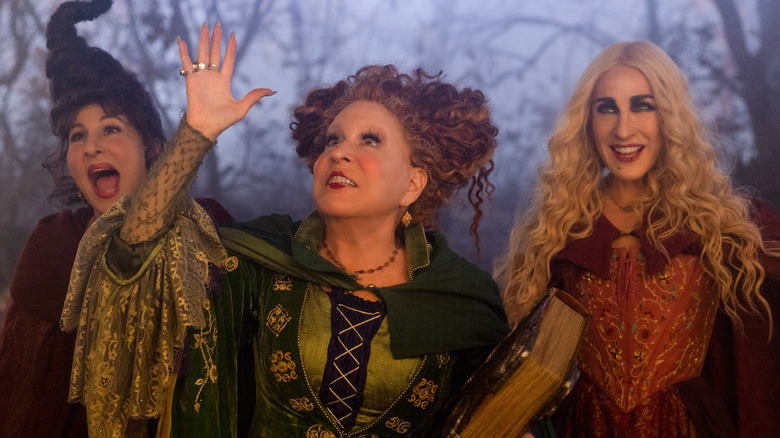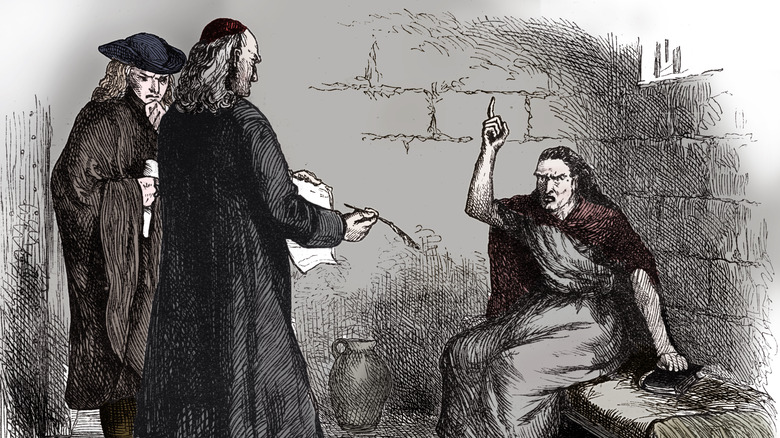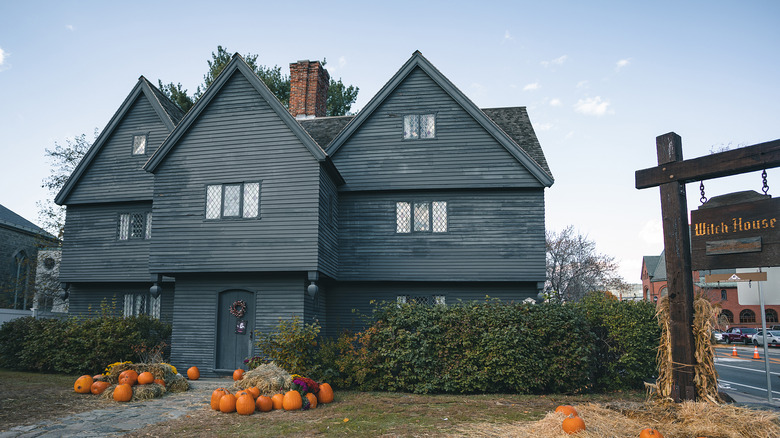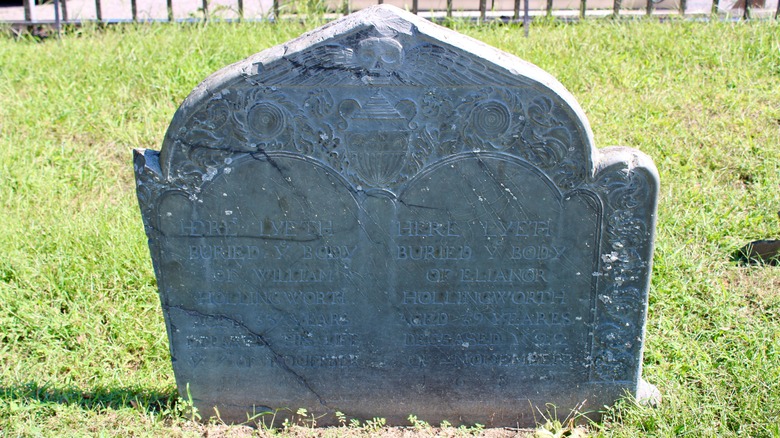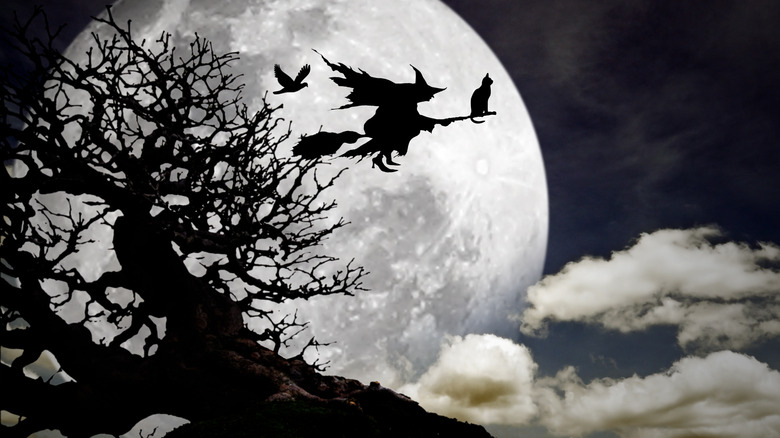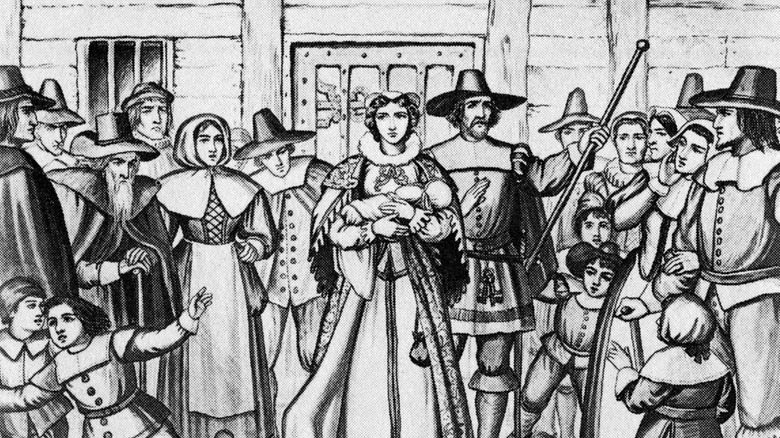The Woman Who May Have Inspired Hocus Pocus
When "Hocus Pocus" originally came to theaters in the summer of 1993, it was considered a box office failure and panned by critics like Roger Ebert who gave it only one star (via ScreenRant). However, the film remains a Disney cult classic. Set in Salem, Massachusetts, where much of the movie was shot on location, the plot revolves around high schoolers who encounter scary sisters from Salem's harrowing witch trial heyday.
The Sanderson sisters, in the "Hocus Pocus" universe, were executed in the 1600s and are accidentally raised from the dead by Max Dennison (Omri Katz), his sister Dani (Thora Birch), and their friend, Allison (Vinessa Shaw). A talkative cat named Thackery Binx helps the children defeat the witches who killed his sister and turned him into a feline in the 1700s.
The plot capitalizes on Salem's tragic history of witch persecution. But one of the characters may be more based in reality than any of the others.
What's in a name?
Sarah Sanderson is the prettiest of the three Sanderson sisters, with flowing blonde hair and a captivating voice. Played by Sarah Jessica Parker, one of Sanderson's most memorable contributions to the film is her eerily haunting "Come Little Children" song, which she sings riding atop of a broomstick through the Salem night. Her character has the power to enchant, and she especially has a fondness for the opposite sex. However, SJP's wicked witch may be based on a real-life woman who shares the name of the actress and the character she plays: Sarah Cloyce (via TheThings). In the spirit of living up to one's name, it should be noted that biblical names like Sarah were popular among the Puritan settlers who lived in 17th century Salem (via Christian Science Monitor).
Puritans were heavily invested in the study of "onomastics," the importance and history of first names. It was a way of divorcing themselves from English society, which valued last names as a signal of class and authority. The Puritans hoped a biblical first name would encourage a person to grow up with the traits associated with the name. "Sarah" comes from the Hebrew word for "princess," and perhaps Sarah Sanderson's character is the most princess-like with her looks (via Family Education).
Shared herstory?
The real Sarah Cloyce was accused of witchcraft, along with her two older sisters, Rebecca Nurse and Mary Eastey (via TheThings). In "Hocus Pocus," Sarah and her two sisters, Mary and Winifred, are sentenced to death for kidnapping two children from the Salem community. One of the Sanderson sisters, Mary, shares her name with Eastey, a real life victim of the Salem judicial system. According to the Salem Witchcraft Museum, it was common for siblings to be accused of witchery, as sorcery was thought to run in the family. It should be noted that women were not the only ones killed for witchcraft and sorcery allegations. Men also were accused, convicted, and executed.
In real life, Cloyce was the only one of her siblings to escape the gallows and survive her sentence as a witch. In the film, Sarah Sanderson is executed with her siblings, but has another dark secret. Sarah's enchanting looks and siren-like voice helped her to seduce her older sister's ex-boyfriend, William "Billy" Butcherson, who is resurrected as a zombie in the future.
Truth stranger than fiction?
The real Sarah Cloyce was no stranger to the horrors of witchcraft accusation. Born Sarah Towne in Salem in 1637, she had six children with her first husband, a blacksmith (via The Salem Witch Museum). When she was widowed, she was left financially destitute and "warned" out of the Topsfield community where she and her family lived. She remarried, to Peter Cloyce of Salem Village, and had another daughter, named Hepzibah. Her own mother, Joanna Towne, had been accused of witchcraft 20 years before Cloyce herself was accused.
Cloyce raised suspicions in the Puritan community after her sister, the elderly Rebecca Nurse, was accused of witchcraft. After Nurse was imprisoned, Cloyce attended Sunday meeting. The Reverend Samuel Parris announced that he would be addressing the existence of the devil and insinuated that he would be talking about Cloyce's older sibling. The 44-year-old Cloyce stood up and left the meeting house and raised eyebrows immediately. According to essayist and author Stacy Schiff in her book "The Witches: Salem, 1692," she may have slammed the heavy latched door, but some believed that the wind simply blew it mysteriously behind her.
Several weeks later, an slaved person named John Indian claimed that a "spectral" version of Cloyce had hovered over him in the church aisles and bit him to drink his blood. An 11-year-old in the congregation added that Cloyce had done the same to her and a warrant was issued for Cloyce's arrest. Cloyce spent nine months in prison before she was released. She died at the age of 66.
De-composing music
"Hocus Pocus" is a horror comedy that sometimes slips into the musical realm. Bette Midler, Kathy Najimy, and Parker perform a rendition of Screamin Jay Hawkins's "I Put a Spell On You" at a fictional Halloween party. But perhaps the most memorable song in the film is the eerie and melancholy Sarah Sanderson song, "Come Little Children," which is meant to enchant children and put them under the witch's spell.
Many people think of the Puritans as especially rigid and stiff and lacking an affinity for the arts, but according to A Puritan's Mind, the religious group which was influenced by the work of John Calvin, actually did not mind the use of certain instruments outside of the church. Dancing on Sundays and use of instruments during church services were verboten, but dancing and music were permissible in private homes as long as the Lord's name was not invoked. So technically, if Sarah Sanderson or Sarah Cloyce sang the bewitching "Come Little Children" tune, it would be okay, except maybe for the broomstick in the air aspect.
Fans of "Hocus Pocus" wondered for a long time if the tune was inspired by an Edgar Allen Poe poem because of its gothic tone (via D. Melhoff). Versions of the song were floating around the internet with new stanzas/verses. Author and blogger D. Melhoff, who wrote a novel also titled "Come Little Children," decided to get to the bottom of this internet theory in 2016 and reached out to the music team behind the 1993 song via email.
Literary links
Notably, Brock Walsh, who composed the song with James Horner, also worked as a producer on the "Golden Girls" theme song (via Discogs). Walsh responded to Melhoff and said that while he was a Poe fan as a child, he did not compose the additional verses nor did he necessarily take inspiration from "The Raven" poet.
Sarah Sanderson may not be the only fictional character associated with the real life Sarah Cloyce. Nineteenth century author Nathaniel Hawthorne was descended from a Puritan judge, William Hathorne, who sentenced a Quaker woman to whipping for witchcraft (via Britannica). Hawthorne was an outspoken critic of Puritanical values and although he would remain in the Northeast for all of his life, he distanced himself from his relatives by adding a "w" to the spelling of his last name. Hawthorne was superstitious, believing that the failure of the family's fortune was a direct result of its involvement in the Salem Witch Trials of 1692. Much of Hawthorne's writing focused on this mysterious world and his short story, "Young Goodman Brown," incorporates the names of Sarah Cloyce and Martha Corey, another one of the witches who was tried during the Salem witch hysteria period (via Course Hero). Corey was executed for the charges against her.
Cloyce was brought to life again in the 1980s by actress Vanessa Redgrave in the series "American Playhouse" (via IMDb). Three episodes in the series portray the trials and tribulations of Cloyce and her two sisters and was based on historic transcriptions of the court proceedings.
